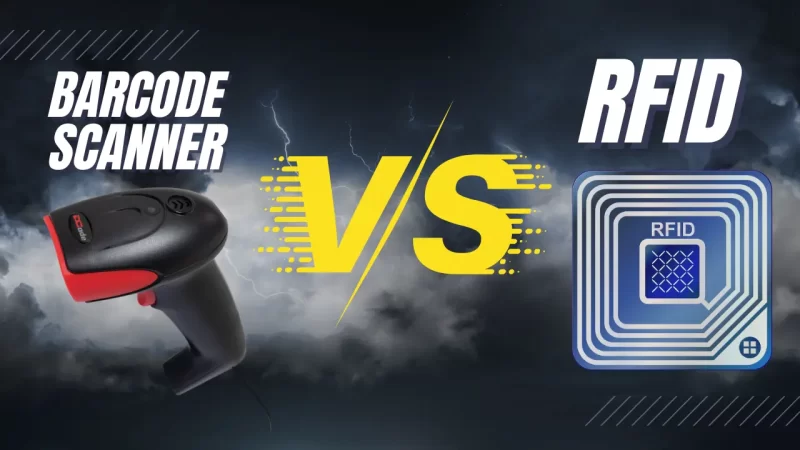What Are Barcode Scanners Used For? A Complete Guide for Beginners – 2025

Introduction to Barcode Scanners
As businesses increasingly embrace automation and efficiency, barcode scanners have emerged as vital tools in streamlining operations. A noteworthy trend points to a significant rise in the use of barcode technology in modern inventory systems, highlighting its growing importance in improving workflow and accuracy .
Barcode scanners are devices that interpret barcodes—visual codes that store data about the attached item. As one expert aptly puts it, “They are used for just about everything,” underscoring their widespread relevance across various sectors.
Community discussions, especially on platforms like Twitter, show growing interest in innovations such as round QR codes, reflecting the ever-evolving nature of this technology [4].
Whether it’s retail, logistics, or healthcare, barcode scanners have become omnipresent, and understanding them is crucial to appreciating their role in today’s digital transformation.
Retail Sector
In the retail world, barcode scanners are instrumental in improving customer experiences and ensuring inventory precision. Retailers use these tools to:
- Speed up checkout times
- Cut down queues
- Boost customer satisfaction
A study found that barcode-enabled stores improved checkout efficiency by 30%.
They also simplify inventory tracking, helping stores:
- Avoid overstock or shortages
- Maintain optimal stock levels
For example, a major retail chain saw a 25% drop in inventory audit discrepancies after using handheld scanners. These benefits show how barcode scanners drive efficiency and better service in retail operations.
Healthcare Applications
In healthcare, barcode scanners improve patient safety and operational efficiency. They are critical for:
- Ensuring correct medication administration
- Reducing manual errors
Hospitals using barcode systems saw up to a 50% reduction in medication errors.
They also improve patient identification accuracy—a hospital reported a 40% drop in ID errors after implementation.
Clearly, barcode scanners enhance both safety and quality in healthcare.
Types of Barcode Scanners
Barcode scanners come in several types, each suited for different use cases:
- Pen-Type Scanners – Compact and budget-friendly, ideal for low-volume scanning.
- Laser Scanners – Fast and precise, used widely in retail.
- CCD Scanners – Durable and close-range, great for POS systems and hospitals.
- Imager Scanners – Camera-based, ideal for reading 2D/QR codes.
- Omnidirectional Scanners – Scans from any angle, perfect for high-traffic environments.
Each type offers unique advantages tailored to business needs, from retail to logistics and manufacturing.
Key Features and Technologies in Barcode Scanners
Barcode scanners come with varied features:
- Laser vs. Imager:
- Laser – Great for fast, long-range scanning
- Imager – Ideal for 1D and 2D barcode decoding
- Wired vs. Wireless:
- Wired – Suitable for stationary workstations
- Wireless (Bluetooth) – Best for mobile operations like warehouses
- Rugged vs. Standard:
- Rugged – Built for harsh conditions (e.g., factories)
- Standard – Perfect for indoor retail or office use
Choosing the right scanner depends on understanding these features in the context of your business.
Benefits of Using Barcode Scanners
Barcode scanners offer a range of advantages:
- Minimize human error
- Boost speed and efficiency
- Improve customer satisfaction
- Enhance inventory accuracy
- Support mobile and harsh environments
These benefits make barcode scanners essential tools in modern operations.
Industry-Specific Applications of Barcode Scanners
Barcode scanners serve many industries:
- In Retail: Quicker transactions, accurate stock management
- In Healthcare: Fewer patient ID and medication errors
- In Logistics: Real-time tracking and reduced misplacement
- In Manufacturing: Efficient part tracking and quality control
Example: A retailer improved checkout by 20%, and manufacturers saw cost savings of up to 15%.
Barcode Scanners and Supply Chain Management
Barcode scanners boost supply chain speed and precision. Benefits include:
- Real-time inventory visibility
- Improved decision-making
- Reduced manual errors and labor costs
A logistics firm improved tracking accuracy by 35%, while another report cited a 25% increase in warehouse efficiency.
Rugged models work even in extreme environments like cold storage. As one expert said, “Barcode tech transforms supply chains through speed and accuracy.”
Future Trends in Barcode Scanning Technologies
Emerging technologies are shaping the future:
- AI & Machine Learning: Enables predictive maintenance (e.g., Zebra’s SmartLens)
- 2D & 3D Barcodes: Provide greater data capacity and accuracy
- Augmented Reality (AR): Improves hands-free scanning (e.g., DHL’s AR glasses)
- Internet of Things (IoT): Enables real-time interconnectivity
These trends make barcode scanners smarter, faster, and more adaptable to industry needs.
FAQs
How is AI enhancing barcode scanning?
AI enables smart, self-monitoring scanners that predict and prevent breakdowns (e.g., SmartLens).
What do 2D/3D barcodes offer?
They store more data, increase scanning precision, and support complex tracking systems.
How does AR benefit warehouse scanning?
Hands-free AR scanning boosts productivity and reduces mistakes. DHL saw a 15% increase in efficiency.
How is IoT transforming barcode systems?
IoT enables real-time communication across devices, improving operational decisions.
What is predictive maintenance?
It uses AI to forecast and fix scanner issues before failure, minimizing downtime.
Conclusion
Barcode scanning technology is rapidly evolving. Innovations in AI, AR, IoT, and predictive maintenance are pushing its capabilities beyond simple product identification.
Companies like Zebra and DHL are leading the way, using these tools to improve operations, minimize errors, and maximize uptime.
The shift to 2D and 3D barcodes, combined with smart IoT integration, is revolutionizing how businesses track inventory and streamline operations.
Forward-thinking businesses that adopt these trends will stay ahead in an increasingly competitive market.



